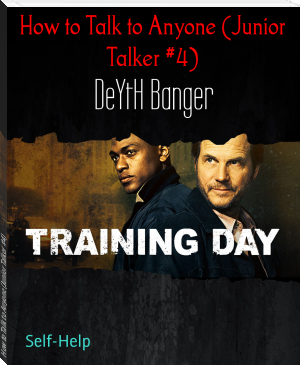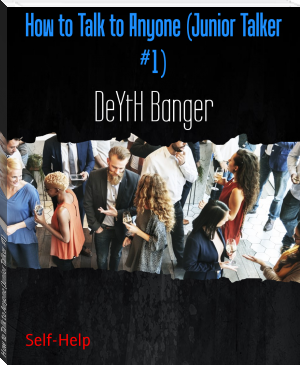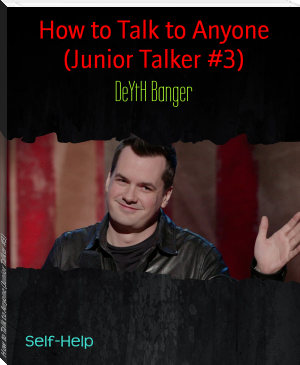How to Talk to Anyone (Junior Talker #5) by DeYtH Banger (old books to read .TXT) 📕

- Author: DeYtH Banger
Book online «How to Talk to Anyone (Junior Talker #5) by DeYtH Banger (old books to read .TXT) 📕». Author DeYtH Banger
4. Panic Attacks Can Occur Expectedly or Suddenly
Christoph Hetzmannseder Getty
The DSM-5 describes two types of panic attacks: expected, or cued, and unexpected. Expected panic attacks occur when the person is provoked by certain cues or triggers. For instance, a person who has a fear of heights (acrophobia) is likely to have a panic attack when on a high floor in a building or on an airplane.
Unexpected panic attacks, on the other hand, occur suddenly without any obvious cues. Anxious and fearful thoughts or external triggers, such as specific phobias or a traumatic event, can bring them on. Unexpected panic attacks are the type most commonly associated with a diagnosis of panic disorder.
5. Avoiding Phobias Can Increase Your Fears
Robert Llewellyn Getty Images
Many panic attack sufferers develop avoidance behaviors by steering clear of situations they believe lead to panic attacks. For example, a person with panic disorder may avoid being in busy shopping malls out of fear that others will witness her having a panic attack. Similarly, a person with a fear of flying (aerophobia) may never travel by plane, knowing that he will have a panic attack on the plane.
Avoidance behaviors may seem logical at first, but they can prevent you from enjoying many different experiences in life. Panic and avoidance may keep you from attending social gatherings or traveling far distances. Plus, avoidance behaviors often strengthen your anxiety, further increasing your fears of certain places or situations.
Instead of avoiding panic-inducing situations, try to breathe through them. The next time you feel a panic attack coming on, bring your attention to your breath. During a panic attack, you may notice that your breath has become quick and shallow. Take control by breathing slowly and purposely. Inhale deeply through your nose, filling your lungs to their capacity. Exhale out of your mouth, expelling all of the air out of your body. Continue to repeat this deep breathing pattern until you feel more relaxed.
If deep breathing exercises and other self-help strategies are not working, you may want to consider finding professional help. Such assistance can help you receive the right diagnosis and develop ways to manage your anxiety and panic attacks. Also, a qualified mental health specialist can provide clear explanations and additional information about panic disorder.
Note: When we talk about irrational thoughts and anxiety and panic disorders... the main problem is that most people are wired in and they have this state... I call it "constantly running".
Irrational Beliefs and Panic Disorder
By Sheryl Ankrom
Panic disorder sufferers often struggle with irrational beliefs. Having a faulty belief system may escalating your experience with anxiety, panic attacks, and other panic-related symptoms. Read ahead to learn more about irrational beliefs and what you can do to overcome them.
Where Does Your Belief System Come From?
One theory of how we perceive the world and act within it is a result of our underlying belief system. This belief system develops from early childhood, based on input from significant others in our lives and our own life experiences. However, developing a belief system is not always a rational process because our assumptions are often based on both logical and illogical input.
Illogical and Self-Defeating Beliefs
Albert Ellis, an American psychologist who is considered the grandfather of cognitive behavioral therapy (CBT), identified three basic irrational beliefs that lead to self-defeat:
“I must do well and win the approval of others or else I am no good.” “Other people must treat me considerately and fairly, or else they are not good and deserve to be condemned and punished.” “I must get what I want, when I want it. If I don’t get what I want, it’s terrible and intolerable.”Let’s say you experience emotions such as sadness, depression or even anger at your inability to attend a social function because you fear having a panic attack. Your fears of having a panic attack at a social gathering may go something like this:
“If I have a panic attack and have to leave, people will think I’m crazy.” "I can’t let anyone find out I have panic disorder. I have to keep my panic secret or people will think less of me.” “If I had a panic attack while at the event, I would be so embarrassed I would never be able to face anyone again.”Perhaps it is not the anticipation of panic that is causing your inner turmoil, but rather your underlying belief system about rejection or failure. For example:
“I must always have other’s approval or else I am worthless.” “If someone rejects me, I am a failure.” “I have to be perfect in order for other people to like me.” “I must be successful.” “I should never show weakness or people will think less of me.” “I have to get the things I want or else I feel worthless.”
Changing Irrational Beliefs
Before we can change our irrational beliefs, we first have to discover what they are. Detecting irrational beliefs is not an easy task because they have been internalized. In order to dispute and change irrational beliefs, we must journey through a process of detecting and debating.
Detecting – It is common for underlying belief systems to have rather rigid boundaries. Often the irrational belief is held in the form of “should,” “must” and “ought” demands that we place on ourselves or others. For example:
Debating – Now that you’ve identified your beliefs, it’s time to debate them. Are they logical? Does it make sense that you must always be successful? Are they realistic? How do you know people will think less of you if they know about your struggles with panic disorder?
A New Way of Thinking
Changing your irrational beliefs leads to a new way of thinking about yourself, others and your environment. These changes in your thoughts will lead to changes in your behaviors and feelings. Your new way of thinking allows you reach a level of acceptance of those imperfections that were once so troubling. As you continue to challenge and debate your irrational beliefs, they lose strength, and you become free of their emotional consequences.
P.S.: The mind can't think clearly while it's in this state.
Maladaptive Behaviors in Panic Disorder
by Sheryl Ankrom
If you experience frequent panic (anxiety) attacks and have been diagnosed with panic disorder or another anxiety disorder, you may have inadvertently developed maladaptive, or poor, patterns of behavior to cope with your situation.
Understanding Maladaptive Behaviors
Maladaptive behaviors inhibit your ability to adjust healthily to particular situations. In essence, they prevent you from adapting or coping well with the demands and stresses of life. Often used to reduce anxiety, maladaptive behaviors result in dysfunctional and non-productive outcomes—in other words, they are more harmful than helpful.
Maladaptive behaviors are classified here as dysfunctional because they tend to provide only short-term relief from anxiety—they don't help you cope with your anxiety in the long run. These behaviors are non-productive because they do nothing to alleviate the root of your problem and may, in fact, serve as reinforcers of the underlying problem.
Maladaptive Behaviors Associated With Panic Disorder
Some common maladaptive behaviors that are related to panic disorder include:
Avoidance: For many people, the symptoms of panic disorder often trigger an array of avoidant behaviors. This can result in agoraphobia, a common complication that occurs in 25 percent to 50 percent of people with panic disorder. Agoraphobia can take a little time to develop, or it can come on rather quickly. Some sufferers believe their agoraphobic symptoms began after their first panic attack. Once agoraphobia takes root, avoidance behaviors often multiply quickly. Substance misuse: People with anxiety disorders, including panic disorder and agoraphobia, sometimes use alcohol or other substances as a means of coping with fear and anxiety. Studies show that people with anxiety disorders are more likely to have an alcohol or other substance abuse disorder than those without an anxiety disorder. Abusing alcohol or other drugs to control stress and anxiety is classified as a maladaptive behavior because it provides only temporary relief from anxiety and actually may create more long-term problems. Substance abuse does not fix the underlying problem and long-term alcohol or drug use or misuse can lead to tolerance, dependence, and for some, addiction. Withdrawing: Many challenges in life require ongoing action—both behaviorally and mentally. Sometimes we struggle and succeed. Sometimes we struggle and fail. When the latter occurs, we can try again, or we can withdraw from the conflict with a resigned acceptance of our situation. When it comes to panic disorder or other anxiety disorders, withdrawing is incompatible with recovery. It is a maladaptive behavior because it means we submit to the illness and become unable to meet the demands of life. In essence, withdrawing in this sense is like giving up. Converting anxiety to anger: It's normal for people who have panic disorder, agoraphobia, or another anxiety disorder to experience frustration because of their condition. Sometimes this frustration can develop into anger—anger toward yourself, anger at your situation, or anger toward others. This type of anger is rooted in anxiety. Anger is a powerful feeling that is a normal part of the human experience. Everyone has felt angry at one time or another, and anger itself is not a bad thing. But if you express your anger in unhealthy ways, it can become a problem. Plus, anger can intensify your anxiety and worsen your panic symptoms. The good news is that anger management programs can help you find more adaptive ways to deal with anxiety.
A Word From Verywell
For many people, the recovery process from anxiety disorders is slow and filled with setbacks. Recovery is accomplished with diligence and a strong resolve to not accept the control that panic attacks and other anxiety-related symptoms have over our lives.
Chapter 3 - Anxiety and More
Note: Calling Bullshit On Big Data lectures are great in showing that
- "We all have opinion"
- "BULLSHIT can be BULLSHIT"
...
Maladaptive Behaviors to Relieve Anxiety
Often used to reduce anxiety, maladaptive behaviors often result in dysfunctional and non-productive outcomes. If you experience frequent panic (anxiety) attacks and have been diagnosed with panic disorder or another anxiety disorder, you may have inadvertently developed maladaptive patterns of behavior to cope with your situation.
People with anxiety disorders, including panic disorder and alcohol or other substances as a means of coping with fear and anxiety. Some studies show that people with anxiety disorders are up to three times more likely to have an alcohol or other substance abuse disorder than those without an anxiety disorder. Abusing alcohol or other drugs to control stress and anxiety is classified as a maladaptive behavior because it provides only temporary relief from anxiety and actually may create more long-term problems. Substance abuse does not fix the underlying problem, and long-term alcohol or drug abuse can lead to tolerance, dependence, and for some, addiction.
Tolerance can result from using a drug over an extended period of time. The result of tolerance is that the drug does not produce the desired effect or the effect is diminished. Tolerance may mean increasing the amount of the drug to produce the desired effect.
Physical dependence to a drug often includes tolerance and can be identified by withdrawal symptoms if the drug is abruptly stopped or decreased. Common withdrawal symptoms associated with alcohol or other drug dependence may include:
Anxiety Diarrhea/stomach upset Insomnia Muscle cramps Headache Decreased concentration Rapid breathing Tremors Seizures
Drug addiction is a brain disease identified by components of physical and psychological dependence. Detoxification can result in the end of physical dependence, but the psychological component maintains a steadfast hold on the addict. It is this component that





Comments (0)